Rajarajeshwara Temple Vemulawada
Rajarajeshwara Temple Vemulawada is one of the most famous Hindu temples in Telangana, India, dedicated to Lord Shiva. It is located in the town of Vemulawada, Telangana. Historically the region was the capital of the Vemulawada Chalukyas who ruled from 750 to 973 CE.
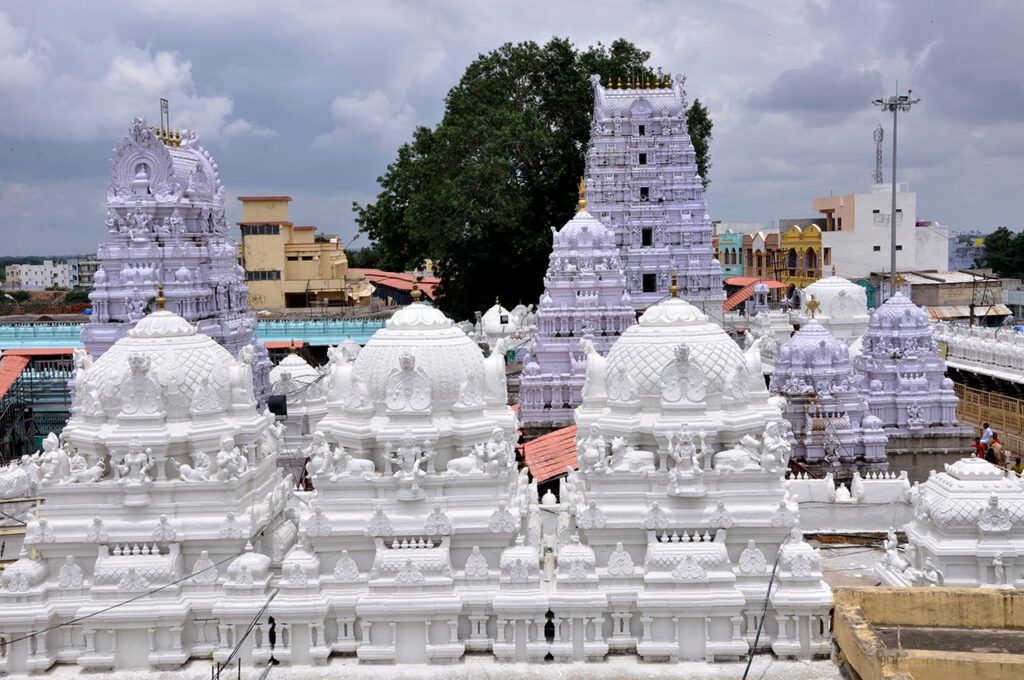
Contents
- 1 History of Rajarajeshwara Temple Vemulawada:
- 2 Legend of Rajarajeshwara Temple Vemulawada:
- 3 Myths of Rajarajeshwara Temple Vemulawada:
- 4 Significance of Rajarajeshwara Temple Vemulawada:
- 5 Rajarajeshwara Temple Timing and Rituals:
- 6 Places to visit near Rajarajeshwara Temple Vemulawada:
- 7 FAQ:
- 8 How to reach Rajarajeshwara Temple Vemulawada:
- 9 Google Maps:
History of Rajarajeshwara Temple Vemulawada:
The Rajarajeshwara Temple in Vemulawada, Telangana, India, boasts a rich and fascinating history that stretches back over a thousand years. While the exact date of its origin is debated, the temple’s story is interwoven with the rise and fall of empires, religious beliefs, and cultural traditions.
Early Beginnings (750-973 AD):
- Vemulawada Chalukyas: The earliest evidence of the temple dates back to the Vemulawada Chalukya dynasty, who ruled the region from 750 to 973 AD. Though the structure we see today is not the original one, inscriptions from this period mention the construction of a temple dedicated to Lord Shiva.
- Raja Narendra and the Dharmagundam: Legend attributes the temple’s construction to Raja Narendra, a descendant of the Pandava prince Arjuna. He is said to have been cured of leprosy by bathing in the holy tank called Dharmagundam and then received a vision of Lord Shiva commanding him to build a temple.
Medieval Era (10th-18th Century):
- Kakatiyas and Bahmanis: The temple continued to flourish under successive dynasties like the Kakatiyas and the Bahmanis. The Kakatiyas are credited with making significant additions to the temple complex, including the construction of the gopuram (gateway tower) and the kalyana mandapam (wedding hall).
- Vijayanagara Empire: During the Vijayanagara Empire’s reign, the temple received patronage and witnessed the construction of several new shrines and mandapas.
Later Developments (19th-20th Centuries):
- Asaf Jahis and Nizams: Under the Asaf Jahi dynasty, the temple continued to be a major pilgrimage center. The Nizams, who ruled Hyderabad State, also made significant contributions to its upkeep and renovation.
- Modern Times: After India’s independence, the temple was placed under the control of the Endowments Department of the Telangana government. Today, it remains a vibrant center of faith and attracts millions of devotees from all over India.
Read More>> Bhadrachalam Temple | Bhadradri Seetha Ramachandra Swamy
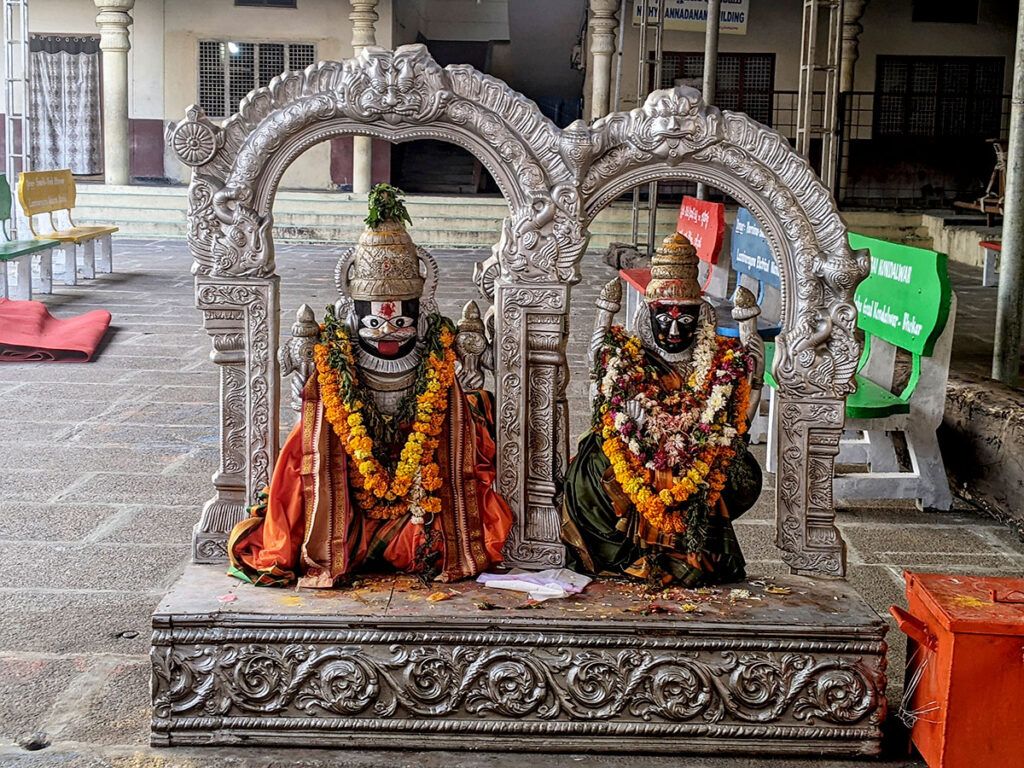
Legend of Rajarajeshwara Temple Vemulawada:
The Rajarajeshwara Temple in Vemulawada is steeped in ancient legends, adding to its mystique and attracting pilgrims for centuries. Here are some of the most popular legends associated with the temple:
1. The Appearance of the Lingam: Legend has it that a farmer named Balaiah saw a bright light emanating from a molehill while plowing his field. Upon digging, he discovered a Swayambhu Shivalingam (self-manifested Shiva Linga) radiating immense power. Word spread like wildfire, drawing devotees to the site, and a temple was eventually built around the holy Lingam.
2. Lakshmi Narasimha: Another legend narrates the story of Lord Vishnu incarnating as Lakshmi Narasimha to protect the devotees from demons. He is said to have resided in a rock cave near the temple, and a shrine dedicated to him stands within the temple complex.
3. Raja Rajeshwara: The temple’s presiding deity, Sri Raja Rajeshwara Swamy (also known as Rajanna), is believed to be a manifestation of both Shiva and Vishnu. This unique dual representation signifies the unity of the two supreme deities, attracting devotees from both Shaivite and Vaishnavite traditions.
4. Dharma Gundam: A sacred tank called Dharma Gundam sits beside the temple. Legend says that a celestial cow created the tank by striking the ground with its hoof. Bathing in this holy water is believed to cleanse sins and cure ailments.
5. The Mysterious Tunnel: A hidden tunnel is rumored to exist beneath the temple, leading to Srisailam, another renowned Shiva temple in Andhra Pradesh. While its existence remains unconfirmed, the legend adds to the temple’s aura of mystery.
6. The Healing Powers of Rajanna: Devotees believe that Rajanna grants wishes and cures ailments. Numerous accounts of miraculous healing attributed to the deity are deeply ingrained in local lore, further solidifying the temple’s spiritual significance.
Read More>> Ananthagiri Temple Vikarabad: Where Myths and Legends Come to Life
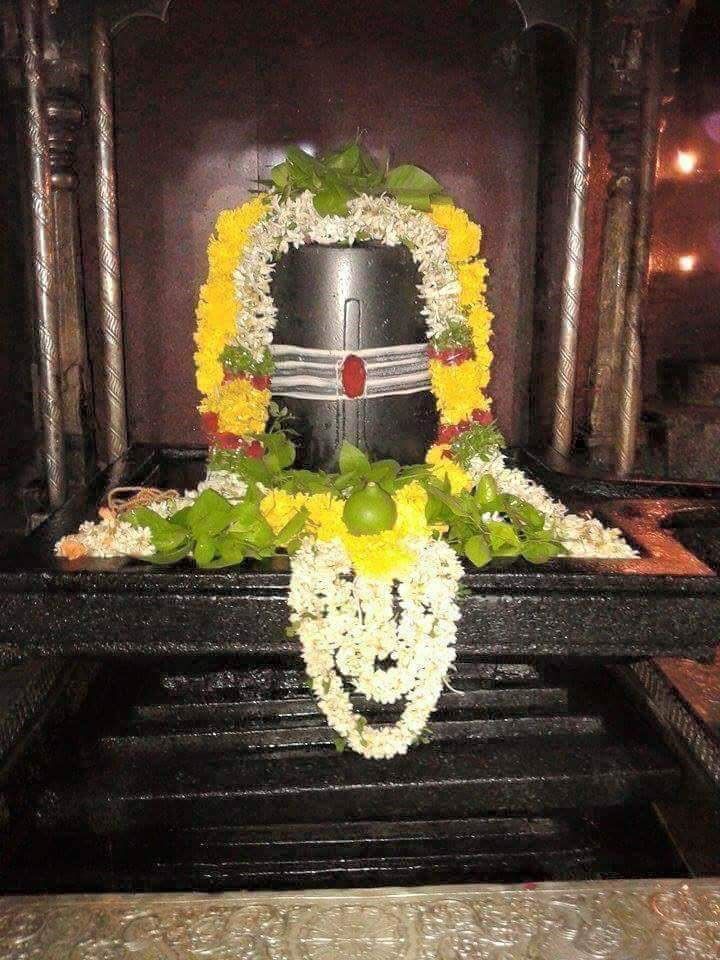
Myths of Rajarajeshwara Temple Vemulawada:
1. Shiva’s Favourite Abode:
According to legend, the sage Narada once asked Lord Shiva which place he loved the most, aside from the Jyotirlinga shrines. Lord Shiva replied that he preferred Vemulawada above all others. This is why the temple holds immense significance for Hindus and is considered an even more sacred place than many Jyotirlingas.
2. The Origin of the Swayambhu Lingam:
The myth surrounding the temple’s main deity, the Swayambhu Lingam, is equally captivating. It is believed that the Lingam emerged naturally from the earth, and that Lord Shiva himself chose Vemulawada as his dwelling place. This divine origin further strengthens the temple’s spiritual significance.
3. The Healing Waters of Dharma Gundam:
Devotees often take a dip in the holy tank known as Dharma Gundam before entering the temple. This tank is believed to possess medicinal properties and is said to cure various ailments. The mythology associated with the tank claims that it was created by Lord Shiva himself to bless devotees with good health and well-being.
4. The Unique Vow of “Kode Mokku”:
The temple is known for its unique vow called “Kode Mokku,” where devotees offer a young bull to the deity after their wishes are fulfilled. This practice is believed to have originated from the legend of a farmer who was blessed with abundant crops after offering a bull to Lord Shiva.
5. The Presence of Shiva’s Family:
The temple houses not only the Swayambhu Lingam but also the idols of Goddess Parvati (Raja Rajeshwari Devi) and Lord Ganesha (Lakshmi Sahitha Siddi Vinayaka). This presence of Shiva’s entire family further emphasizes the temple’s importance as a sacred site for worshipping all aspects of the divine.
Read More>> Sri Siddhi Vinayaka Temple Secunderabad – Temple of Miracles
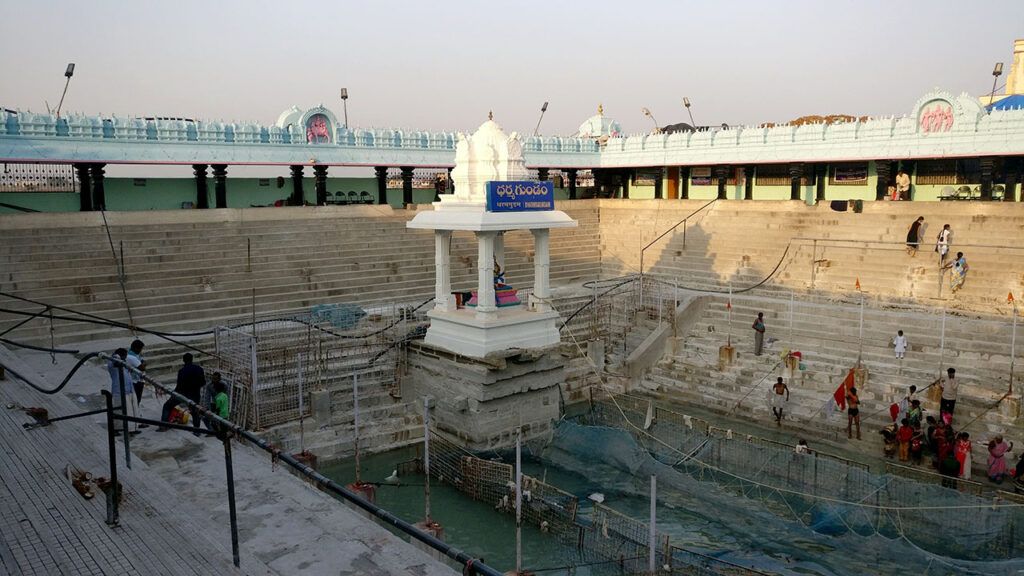
Significance of Rajarajeshwara Temple Vemulawada:
Religious Significance:
- Dedicated to Lord Shiva: The temple is primarily dedicated to Lord Shiva, one of the principal deities in Hinduism. It houses a majestic Shiva Lingam, considered to be self-manifested (Swayambhu). Devotees believe that offering prayers and performing rituals here brings immense blessings and fulfills their wishes.
- Jyotirlinga Shrine: Though not officially classified as one of the twelve Jyotirlingas, the temple is revered as a Jyotirlinga by many devotees. Its association with the powerful deity enhances its religious significance.
- Dharma Gundam: This sacred tank located within the temple complex is believed to possess medicinal properties. Devotees take a holy dip in the tank before offering prayers to Lord Shiva, seeking purification and spiritual merit.
Cultural Significance:
- Historical Importance: The temple dates back to the 8th century AD, making it a significant historical monument. It was built by the Vemulawada Chalukyas, who ruled the region during that period.
- Architectural Marvel: The temple structure is a fine example of Chalukyan architecture. Its intricate carvings, sculptures, and gopurams (gateway towers) are a testament to the craftsmanship of the era.
- Festivals and Celebrations: The temple celebrates several festivals throughout the year, including Maha Shivaratri, Brahmotsavam, and Karthika Somavaram. These vibrant festivals draw large crowds of devotees, showcasing the rich cultural heritage associated with the temple.
- Social Impact: The temple plays a crucial role in the social and economic development of the region. It provides employment opportunities to the local community and generates revenue for various developmental activities.
- Tourist Attraction: The temple is a popular tourist destination, attracting visitors from across the globe. Its religious significance, historical value, and architectural beauty make it a must-visit for anyone interested in Indian culture and heritage.
Read More>> Dakshin Ke Badrinath Temple Hyderabad
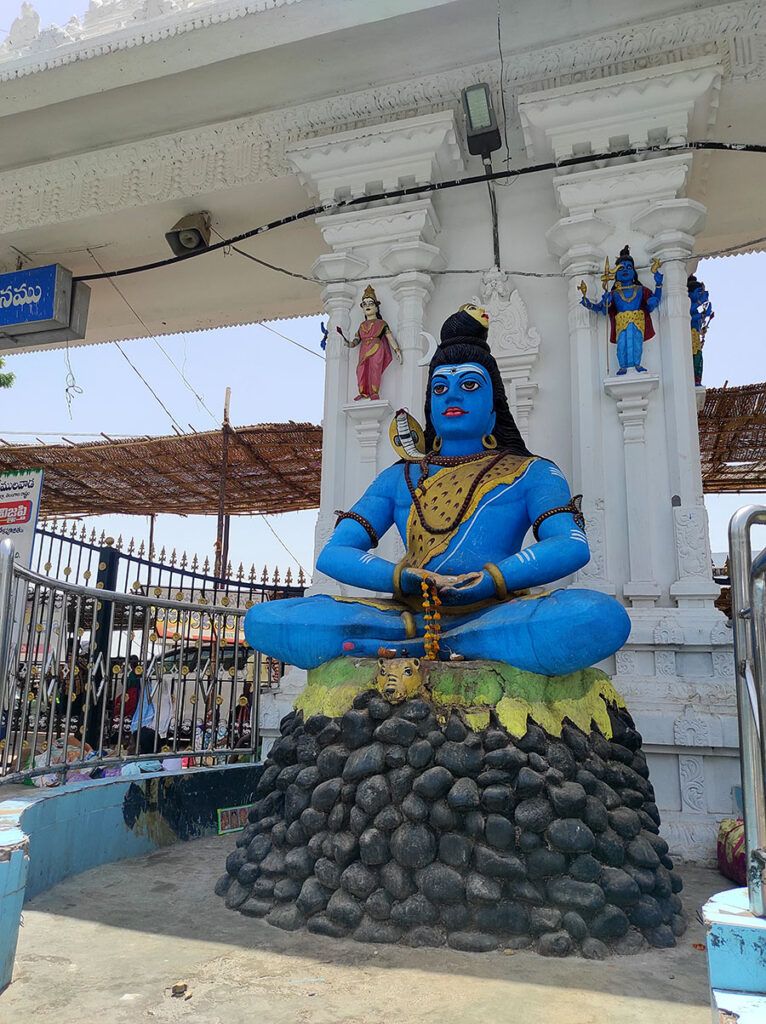
Rajarajeshwara Temple Timing and Rituals:
Temple Timings:
- Daily Darshan: 4:00 AM to 9:00 PM
- Special Darshan Timings:
- Abhishekam: 6:00 AM, 10:00 AM, 5:00 PM
- Arati: 5:00 AM, 7:00 AM, 12:00 PM, 7:00 PM
Temple Rituals:
- Abhishekam: This is a ritualistic bath performed on the Shiva Linga with various liquids like milk, curd, honey, ghee, and panchamrita.
- Rudrabhishekam: This is a special Abhishekam performed with 11 different liquids.
- Maha Puja: This is a grand puja performed with various offerings and chanting of mantras.
- Kumkuma Puja: This is a puja performed with Kumkuma (vermilion).
- Palki Seva: This is a ritual where the deity is taken out in a procession on a palanquin.
- Kode Mokkulu: This is an age-old ritual where devotees offer a pair of oxen made of jaggery or turmeric to the deity.
Other important Sevas:
- Abhiseka Puja – Rs. 200/- & Rs. 600/-
- Sri Swamy Varla Kalyanam – Rs.1000/-
- Kumkuma Puja – Rs.150/-
- Pallaki Seva & Pedda Seva – Rs.200/- & Rs.350/- respectively.
- Maha Puja – Rs.250/-
- Aakula Puja – Rs.600/-
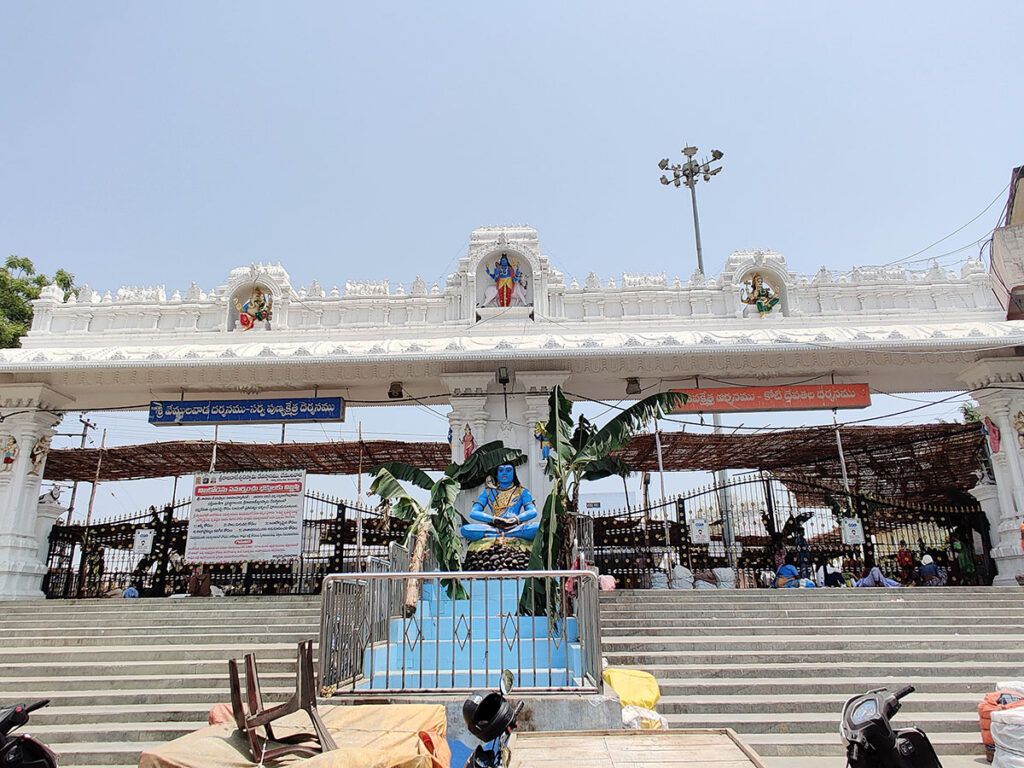
Places to visit near Rajarajeshwara Temple Vemulawada:
- Sri Raja Rajeshwara Swamy Temple: Start your visit with the main temple itself. The Rajarajeshwara Temple is known for its historical and architectural significance. It’s a key pilgrimage site, and devotees come to offer prayers and seek blessings.
- Sarangapur Hanuman Temple: Located around 20 kilometers from Vemulawada, Sarangapur Hanuman Temple is dedicated to Lord Hanuman. It’s believed to be a powerful shrine, and devotees visit to seek the blessings of Lord Hanuman.
- Kondagattu Anjaneya Swamy Temple: Another significant temple dedicated to Lord Hanuman, Kondagattu Anjaneya Swamy Temple is situated about 35 kilometers from Vemulawada. The temple is located on a hillock, providing scenic views of the surrounding area.
- Basar Saraswathi Temple: If you’re interested in visiting a temple dedicated to the goddess Saraswathi, you can head to Basar, which is around 80 kilometers from Vemulawada. The Basar Saraswathi Temple is a popular pilgrimage site, especially for those seeking blessings for education and knowledge.
- Dharmapuri Lakshmi Narasimha Swamy Temple: Dharmapuri, situated about 50 kilometers from Vemulawada, is known for its Lakshmi Narasimha Swamy Temple. The temple is located on the confluence of the Godavari River and the Pranahita River, making it a picturesque location.
- Kaleswaram: Kaleswaram is a temple town located at the confluence of the Godavari and Pranahita rivers. It’s about 100 kilometers from Vemulawada. The Kaleswara Mukteswara Swamy Temple is one of the key attractions in this region.
- Vemulawada Anjaneya Swamy Temple: Apart from the main Raja Rajeshwara Temple, there is another temple dedicated to Lord Hanuman in Vemulawada. It’s known as the Vemulawada Anjaneya Swamy Temple and is a significant religious site.
FAQ:
Q: Where is the Rajarajeshwara Temple located?
A: The Rajarajeshwara Temple is located in the town of Vemulawada in the Karimnagar district of Telangana, India. It is about 150 kilometers from Hyderabad, the capital of Telangana. The temple is situated on the banks of the Godavari River.
Q: When was the Rajarajeshwara Temple built?
A: The Rajarajeshwara Temple was built in the 11th or 12th century by one of the governors of the Kalyani Chalukya dynasty. The temple is a fine example of Chalukya architecture.
Q: Who is the presiding deity of the Rajarajeshwara Temple?
A: The presiding deity of the Rajarajeshwara Temple is Lord Shiva. He is locally known as Rajanna. The idol of the main deity is in the form of a Neela Lohitha Siva Lingam.
Q: What are the other temples in the Rajarajeshwara Temple complex?
A: The Rajarajeshwara Temple complex houses several other temples dedicated to other deities, including:
- Anantha Padmanabha Swamy Temple
- Bhimeshwara Swamy Temple
- Kodanda Rama Temple
- Kasi Visweswara Temple
- Tomb of Muslim saint
Q: What are the festivals celebrated at the Rajarajeshwara Temple?
A: The Rajarajeshwara Temple is a major pilgrimage center and is visited by devotees from all over India. The temple celebrates several festivals throughout the year, including:
- Mahashivratri
- Karthika Deepam
- Ugadi
- Krishna Janmashtami
- Hanuman Jayanti
For more information visit temple official website https://vemulawadatemple.telangana.gov.in/
How to reach Rajarajeshwara Temple Vemulawada:
By Air:
The nearest airport to Vemulawada is Rajiv Gandhi International Airport (HYD) in Hyderabad. From the airport, you can hire a taxi or take a bus to reach Vemulawada. The distance is approximately 150 kilometers, and the journey takes around 3 to 4 hours by road.
By Train:
The closest railway station to Vemulawada is Karimnagar Railway Station (station code: KRMR). You can take a train to Karimnagar and then proceed to Vemulawada by taxi or bus. The distance between Karimnagar and Vemulawada is around 35 kilometers.
By Road:
- From Hyderabad:
- Vemulawada is about 150 kilometers from Hyderabad, and you can reach it by road.
- You can take a bus from major bus terminals in Hyderabad to Vemulawada. There are also private taxi services available.
- By Bus:
- Vemulawada is well-connected by road, and there are regular bus services from major towns and cities in Telangana.
- You can check with the local bus station or use private bus services to reach Vemulawada.
- By Car:
- If you are driving, you can use navigation apps or maps to guide you to Vemulawada. The roads are generally well-maintained.

One Comment